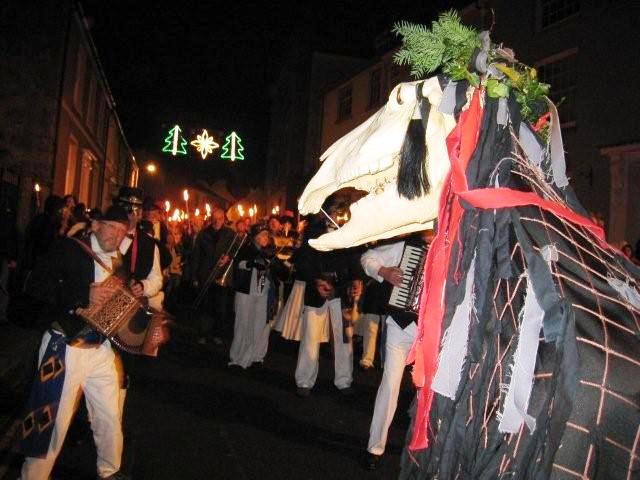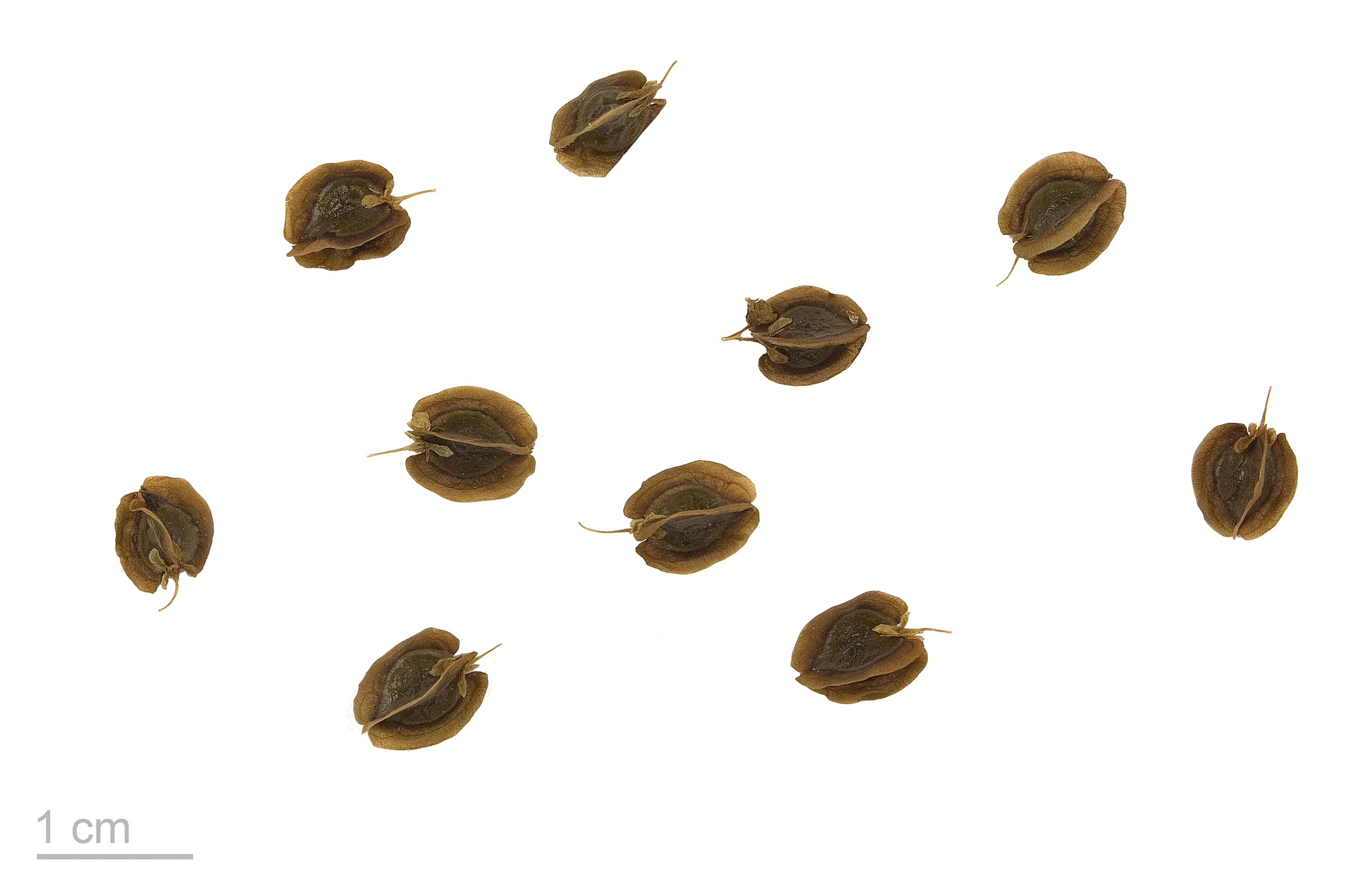|
Guise Dancing
Guise dancing (sometimes known as goose, goosey or geese dancing) is a form of community mumming practiced during the twelve days of Christmastide, that is, between Christmas Day and Twelfth Night in West Cornwall, England, UK. Today, guise dancing has been appropriated for feast days at other times of the year. Guise dancers dress in a disguise to hide their identity allowing them to perform in an outlandish or mischievous manner in the hope of receiving payment of food or money. The principal activities associated with guise dancing have changed through time. These have included the performance of Christmas plays such as Duffy and the Devil or St George and the Turkish Knight and traditional Cornish dance, music and song. Historical description Guise dancing was observed in the late 19th century by Cornish antiquarian M. A. Courtney who reported that the practice had been largely eliminated by 1890 in Penzance due to a decline in the traditional nature of the celebrations a ... [...More Info...] [...Related Items...] OR: [Wikipedia] [Google] [Baidu] |
Montol087
The Montol Festival (often just Montol) is an annual festival in Penzance, Cornwall, United Kingdom, which has been held on 21 December each year since 2007. The festival is a revival or reinterpretation of many of the traditional Cornish midwinter customs & Christmas traditions formerly practiced in and around the Penzance area and common to much of Cornwall at one point. The festival spans several days, but the main events are held on the traditional date of the feast of St Thomas the Apostle, usually 21 December, which always coincides with the winter solstice. Origin and history Montol came about from the same community which had created Golowan, a midsummer festival also held in Penzance, though different people were involved. The idea was formed after the success of Golowan, in order to celebrate the winter solstice in a similar manner. Montol sought to revive practices recorded by antiquarians, some of which reportedly only died out after the Second World War. The first fe ... [...More Info...] [...Related Items...] OR: [Wikipedia] [Google] [Baidu] |
William Bottrell
William Bottrell (1816–1881) was born at Rafta, St Levan in Cornwall on 7 March 1816. He contributed greatly to the preservation of Cornish mythology. Both he and Thomas Quiller Couch contributed folk stories of West Cornwall for Robert Hunt's ''Popular Romances of the West of England'', published in 1865. Although Bottrell's contributions were acknowledged in Hunt's introduction to the book (his name given there as Botterell), there was no individual acknowledgement for each story, which was the case for Couch's contributions. The "Cornish Telegraph" invited Bottrell to write his own versions for their newspaper. These were published between 1867 and 1869 and then published as ''Traditions and Hearthside Stories of West Cornwall'' in 1870. Hunt and Bottrell were both intent on preserving the old legends but Bottrell's stories were generally much longer than similar versions published by Hunt, reflecting the way the old story tellers, known as "droll tellers", embellished the b ... [...More Info...] [...Related Items...] OR: [Wikipedia] [Google] [Baidu] |
West Cornwall May Day Celebrations
The West Cornwall May Day celebrations are an example of folk practices found in the western part of Cornwall, England, United Kingdom, associated with the coming of spring. The celebration of May Day is a common motif throughout Europe and beyond. In Cornwall there are a number of notable examples of this practice including the Obby Oss in Padstow and Furry Dance or Flora day in Helston. The celebrations are in contrast to the Cornish midwinter celebrations that occur every year such as the Penzance Montol Festival and the Padstow Mummer's Day festival. Practice before the 20th century Prior to the 20th century it was common for young residents of the towns of Penzance and St Ives and other nearby settlements to conduct their own festivities. During this festival it was usual to make 'May Horns' usually fashioned from tin cans and 'May Whistles' made from small branches of the sycamore tree. The tree branches also formed decorations for people's homes. The following is fro ... [...More Info...] [...Related Items...] OR: [Wikipedia] [Google] [Baidu] |
Allantide
Allantide ( kw, italic=yes, Kalan Gwav, meaning ''first day of winter'', or ''Nos Kalan Gwav'', meaning ''eve of the first day of winter'' and ''Dy' Halan Gwav'', meaning ''day of the first day of winter''), also known as Saint Allan's Day or the Feast of Saint Allan, is a Cornish festival that was traditionally celebrated on the night of 31 October, as well as the following day time, and known elsewhere as Allhallowtide. The festival in Cornwall is the liturgical feast day of St Allan (also spelled St Allen or St Arlan), who was the bishop of Quimper in the sixth century. As such, Allantide is also known as Allan Night and Allan Day. The origins of the name Allantide also probably stem from the same sources as Hollantide (Wales and the Isle of Man) and Hallowe'en itself. As with the start of the celebration of Allhallowtide in the rest of Christendom, church bells were rung in order to comfort Christian souls in the intermediate state. Another important part of this festiv ... [...More Info...] [...Related Items...] OR: [Wikipedia] [Google] [Baidu] |
Tom Bawcock's Eve
Tom Bawcock's Eve is an annual festival, held on 23 December, in Mousehole, Cornwall. The festival is held in celebration and memorial of the efforts of legendary Mousehole resident Tom Bawcock to lift a famine from the village by going out to fish in a severe storm. During this festival Stargazy pie (a mixed fish, egg and potato pie with protruding fish heads) is eaten and depending on the year of celebration a lantern procession takes place. Origins There are several theories of the origins of this festival, but the first recorded description was made by Robert Morton Nance in 1927 in the magazine ''Old Cornwall''. Nance described the festival as it existed around the start of the 20th century. Within this work Nance also speculated that the name Bawcock was derived from Beau Coq ( French) - he believed the cock was a herald of new light in Pagan times and the origins of the festival were pre-Christian. The most likely derivation of the name 'Bawcock' is from Middle Englis ... [...More Info...] [...Related Items...] OR: [Wikipedia] [Google] [Baidu] |
Mummers Play
Mummers' plays are folk plays performed by troupes of amateur actors, traditionally all male, known as mummers or guisers (also by local names such as ''rhymers'', ''pace-eggers'', ''soulers'', ''tipteerers'', ''wrenboys'', and ''galoshins''). Historically, mummers' plays consisted of informal groups of costumed community members that visited from house to house on various holidays. Today the term refers especially to a play in which a number of characters are called on stage, two of whom engage in a combat, the loser being revived by a doctor character. This play is sometimes found associated with a sword dance though both also exist in Britain independently. Mumming spread from the British Isles to a number of former British colonies. It is sometimes performed in the street but more usually during visits to houses and pubs. It is generally performed seasonally or annually, often at Christmas, Easter or on Plough Monday, more rarely on Halloween or All Souls' Day, and often wit ... [...More Info...] [...Related Items...] OR: [Wikipedia] [Google] [Baidu] |
Turkey Rhubarb
''Rheum palmatum'' is a species of flowering plant in the knotweed family Polygonaceae. It is commonly called Chinese rhubarb, ornamental rhubarb, Turkey rhubarb or East Indian rhubarb. ''Rheum palmatum'' is a herbaceous perennial related to the edible rhubarb. It is primarily used in traditional medicine, and as an ornamental subject in the garden. Taxonomy Agnia Losina-Losinskaja proposed classifying it in the section ''Palmata'' in the ''Flora SSSR'' in 1936. In the 1998 ''Flora Republicae popularis Sinicae'' A. R. Li maintains this classification for this species. Description Its lobed leaves are large, jagged and hand-shaped, growing in width to two feet. Chinese rhubarb has thick, deep roots. Similar species The species ''Rheum tanguticum'' is closely related to ''R. palmatum''. ''R. palmatum'' can be distinguished from ''R.'' × ''hybridum'', the garden rhubarb we eat, by size; while garden rhubarb only grows to a few feet in height, Chinese rhubarb can grow to ... [...More Info...] [...Related Items...] OR: [Wikipedia] [Google] [Baidu] |
BBC Regional Programme
The BBC Regional Programme was a radio service which was on the air from 9 March 1930 – replacing a number of earlier BBC local stations between 1922 and 1924 – until 1 September 1939 when it was subsumed into the Home Service, two days before the outbreak of World War II. Both the National Programme and the Regional Programme provided a mixed mainstream radio service. Whilst the two services provided different programming, allowing listeners a choice they were not streamed to appeal to different audiences, rather they were intended to offer a choice of programming to a single audience. While using the same transmitters, the National Programme broadcast significantly more speech and classical music than its successor, the Light Programme. Similarly, the Regional Programme broadcast much more light and dance music than its successor, the Home Service. History Development When the British Broadcasting Company first began transmissions on 14 November 1922 from station 2LO ... [...More Info...] [...Related Items...] OR: [Wikipedia] [Google] [Baidu] |
Guise Dancers Parading Through St Ives, Cornwall (1974)
Guise (; nl, Wieze) is a commune in the Aisne department in Hauts-de-France in northern France. The city was the birthplace of the noble family of Guise, Dukes of Guise, who later became Princes of Joinville. Population Sights The remains of the medieval castle of Guise, the seat of the Dukes of Guise, is within the commune. Economy Guise is the agricultural centre of the northern area of Aisne. Miscellaneous Guise was the birthplace of Camille Desmoulins (1760–1794), a journalist and politician who played an important part in the French Revolution, and that of Jeanne Macherez who was a heroine during the World War I. Over a period of 20 years, beginning about 1856, Jean-Baptiste Godin built the (the Social Palace), an industrial and communal residential complex that was a separate community within Guise. It expressed many of his ideas about developing social sympathy through improved housing and services for workers and their families, influenced by the ideas of the ... [...More Info...] [...Related Items...] OR: [Wikipedia] [Google] [Baidu] |
Montol Festival
The Montol Festival (often just Montol) is an annual festival in Penzance, Cornwall, United Kingdom, which has been held on 21 December each year since 2007. The festival is a revival or reinterpretation of many of the traditional Cornish midwinter customs & Christmas traditions formerly practiced in and around the Penzance area and common to much of Cornwall at one point. The festival spans several days, but the main events are held on the traditional date of the feast of St Thomas the Apostle, usually 21 December, which always coincides with the winter solstice. Origin and history Montol came about from the same community which had created Golowan, a midsummer festival also held in Penzance, though different people were involved. The idea was formed after the success of Golowan, in order to celebrate the winter solstice in a similar manner. Montol sought to revive practices recorded by antiquarians, some of which reportedly only died out after the Second World War. The first ... [...More Info...] [...Related Items...] OR: [Wikipedia] [Google] [Baidu] |


